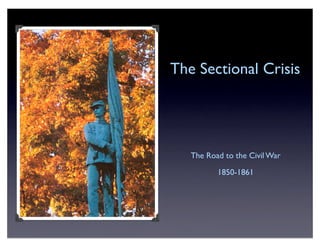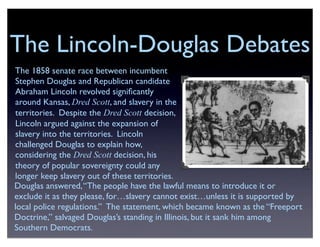Sectional crisis
- 1. The Sectional Crisis The Road to the Civil War 1850-1861
- 2. The Compromise of 1850 Known as the âGreat Compromiser,â Henry Clay formulated the Compromise of 1850 as one of his last signiïŽcant political works. It provided for the admission of California as a free state; it established the western border of Texas in exchange for federal assumption of Texasâs pre-annexation debts; it established popular sovereignty as the method for allowing or banning slavery in the territories gained in the Mexican War; it ended the slave trade in the nationâs capital; and it strengthened the federal Fugitive Slave Act. As a whole, the Compromise could not have passed. Skillfully, the young senator Stephen Douglas successfully maneuvered the individual elements of the compromise through Congress.
- 3. Slave Catchers The Fugitive Slave Act, reinvigorated by the Compromise of 1850, enabled Southern slave owners to deputize northern citizens as they tried to recover runaway âproperty.â Captured slaves had a moment in court (though they could not speak on their own behalf); by law, judges earned $5 for hearing the case and another $5 for sending the defendant back into slavery. The system brought the injustices of slavery home to the North like nothing else could. In Boston, local citizens successfully protected a few African Americans from being returned to slavery. A mob tried but failed to rescue Anthony Burns in 1854; supporters ultimately purchased his freedom and returned him to Boston the following year. Such incidents made abolitionists of countless Northerners.
- 4. UncleTomâs Cabin Harriet Beecher Stowe brought slavery home to Northerners in another way with the 1852 publication of her novel Uncle Tomâs Cabin. The story provided a heart- rending, if not altogether accurate, introduction to slave life. First as a book, then as a play, Uncle Tomâs story forced Americans to ponder the morality of slavery. When President Lincoln ïŽrst met Stowe at the White House in 1862, he greeted her saying,âSo you are the little woman who made this great war.â
- 5. The Kansas-Nebraska Act Political conïŽicts of interest often result in scandal. In 1854 the result, instead, was a giant step toward civil war. Senator Stephen Douglas, a rising star in the Democratic Party, proposed in 1854 to organize the territories of Kansas and Nebraska in preparation for their ultimate statehood. To secure the votes of Southerners, Douglas proposed that popular sovereignty prevail in these territories, contrary to the terms of the Missouri Compromise. The conïŽict of interest? Douglas was a director of the Illinois Central Railroad; territorial organization would permit advancement of a transcontinental railroad, ideally (for Douglas) with a terminus in Chicago. The Act passedâ with deadly repercussions.
- 6. The Shake-up of Political Parties The overwhelming election of Democratic candidate Franklin Pierce in 1852 signaled the demise of the Whig Party. The âCotton Whigsâ of the South found refuge in the Democratic Party. In the North, party politics grew complicated. The American Party (the Know-Nothings)âwith some presence in the Southâ emerged as a nativist, anti-immigrant party; the Republicansâa purely Northern partyâattracted Free Soilers, former Whigs, and disenchanted Democrats with a ïŽrm stand against any policy that would permit slavery in U.S. territories.The 1856 election would pit Democratic Candidate James Buchanan (see his âticket,â adjacent) against Republican John Fremont and American Party candidate Millard Fillmore. Buchanan triumphed, but Fremontâs showing gave Republicans hope for the future.
- 7. ConïŽict in Kansas The Kansas-Nebraska Act made a battleground of Kansas, where pro- slavery and anti-slavery advocates gathered to win their respective causes. Agents for both sides canvassed the country to enlist supporters to move to Kansas and take a stand. The broadside to the right is a plea to the people of the North to attend a meeting and support the side of freedom.
- 8. John Brown and âBleeding Kansasâ John Brown grew up in my hometown of Hudson, Ohio. While debates continue over his sanity, there is no questioning his commitment to the anti- slavery cause. Brown ïŽrst hit the news when he and six accomplices murdered ïŽve pro-slavery men at Pottawatomie Creek in Kansas. Kansas had already grown contentious, with two questionable governments vying for control of the territory. The Pottawatomie Massacre simply raised the ante.
- 9. Brooks Attacks Sumner The famous orator Charles Sumner, speaking in the Senate about the atrocities in Kansas, used the occasion to defame his fellow senator Andrew Butler of South Carolina. Butler was absent and unable to defend his name. Butlerâs nephew, Congressman Preston Brooks, took it upon himself to avenge Sumnerâs improprietiesâby beating Sumner on the Senate ïŽoor with a heavy cane! Northerners made Sumner a martyr; Southerners praised Brooks by sending him canes with which to beat other impudent Northerners.
- 10. The Dred Scott Case The Dred Scott case gave the Supreme Court the opportunity to join the debate over the place of slavery in the territories. As a slave, Dred Scott had traveled with his master, a physician from Missouri, through the free state of Illinois and the free territory of Wisconsin. Well after his return to Missouri, Scott ïŽled a suit for his freedom on the grounds of his residence in these free lands. Andrew Jacksonâs old friend Roger Taney now sat as chief justice of the Supreme Court, and he rejected Scottâs argument with a decision full of disturbing implications.
- 11. Taneyâs Decision Taney ïŽrst declared that Scott had no standing to ïŽle suit in federal court since, as a black man, he was not a citizen. Taney might have stopped there, but he argued further that, since he ïŽled his suit in Missouri, Scott had no recourse to Illinois law. Additionally, and most provocatively,Taney argued that the 5th amendment protection of property meant that an owner could not be deprived of his property âwithout due process.â Taney there invalidated the Missouri Compromise as unconstitutional, with this admonition to Congress: not only was Congress powerless to exclude slavery from any territory, but it had a constitutional duty to protect slavery in any territory.
- 12. The Lecompton Constitution Not long after Taneyâs decision, controversy in Kansas arose yet again. Proslavery forces in Kansas applied for statehood, basing their proposed âLecompton Constitutionâ on an election boycotted by anti-slavery residents. President Buchanan rejected the advice of his governor in Kansas and pushed for the territoryâs admission to the union as a slave state. Stephen Douglas successfully led the ïŽght in Congress to defeat the measure.
- 13. The Lincoln-Douglas Debates The 1858 senate race between incumbent Stephen Douglas and Republican candidate Abraham Lincoln revolved signiïŽcantly around Kansas, Dred Scott, and slavery in the territories. Despite the Dred Scott decision, Lincoln argued against the expansion of slavery into the territories. Lincoln challenged Douglas to explain how, considering the Dred Scott decision, his theory of popular sovereignty could any longer keep slavery out of these territories. Douglas answered,âThe people have the lawful means to introduce it or exclude it as they please, forâĶslavery cannot existâĶunless it is supported by local police regulations.â The statement, which became known as the âFreeport Doctrine,â salvaged Douglasâs standing in Illinois, but it sank him among Southern Democrats.
- 14. Harperâs Ferry John Brown returned to the national scene in the fall of 1859 with a daring, ill- advised plan to raid the federal arsenal at Harperâs Ferry,Virginia. With some secret support from prominent abolitionists, Brown planned to distribute captured weapons and initiate an uprising among local slaves. The plan went badly from the start. Trapped within the arsenal (ironically by Marines commanded by Robert E. Lee), most of Brownâs men were killed or captured within 36 hours. Tried and convicted of treason, Brown was hanged on December 2, 1859, a new martyr among some in the North, a villain and a traitor to most in the South.
- 15. The Election of 1860 All of these various threads were woven together in the election of 1860. Stephen Douglas, having lost the support of Southerners as a result of his Freeport Doctrine, ran with the backing of Northern Democrats. Vice President John Breckinridge gained the nomination of Southern Democrats. Douglasâs old foe Abraham Lincoln took the Republican nomination from more experienced opponents. John Bell ran a dark horse campaign under the banner of a newly formed Constitutional Union Party. To the great dismay of Southerners, Lincoln took the election without a single electoral vote south of the Mason-Dixon line.
- 16. SecessionAlmost immediately, South Carolina âïŽre-eatersâ campaigned for secession, and they traveled throughout the South urging support from other southern states. The up-and-coming artist Winslow Homer made this drawing of South Carolinaâs congressional delegation as they resigned their positions in December 1860. Fearful that a Republican victory meant an end to their control of the issue of slavery at the federal level, secessionists gambled that by embarking on a âpre-emptive counter-revolution,â they could preserve slavery permanently. Lincoln took the oath of ofïŽce with South Carolina and other deep South states already having declared secession. Lincolnâs challenge, which would consume his presidency, was how to restore the union.















